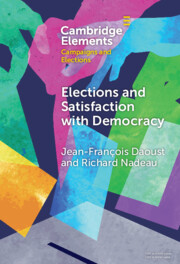Element contents
Elections and Satisfaction with Democracy
Published online by Cambridge University Press: 08 September 2023
Summary
- Type
- Element
- Information
-
Online ISBN: 9781009128032Publisher: Cambridge University PressPrint publication: 05 October 2023
References
- 2
- Cited by



